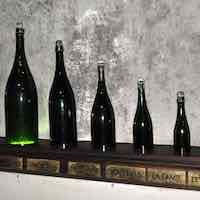Bottle Sizes and Taste
Champagne bottles come in many sizes for many occasions. When selecting a bottle other than the standard 750 ml. bottle, keep in mind that the bottle size can make a difference in the taste experience.
What’s in a bottle? They come in ten different sizes, but some sizes are more difficult to find than others.
| Name | Standard Bottle Equivalent | Volume |
|---|---|---|
| Split | 1/4 Bottle | 187 ml. |
| Demi | 1/2 Bottle | 375 ml. |
| Bottle | 1 Bottle | 750 ml. |
| Magnum | 2 Bottles | 1.5 ml. |
| Jeroboam (also Double Magnum) | 4 Bottles | 3 ml. |
| Rehoboam | 6 Bottles | 4.5 ml. |
| Methuselah | 8 Bottles | 6 ml. |
| Salamanzar | 12 Bottles | 9 ml. |
| Balthazar | 16 Bottles | 12 ml. |
| Nebuchadnezzar | 20 Bottles | 15 ml. |
Large Champagne Bottles

The list goes on from here, but in reality large bottles (bigger than a magnum) are just not practical. In the past, larger sizes were often produced by pouring champagne from standard or magnum sized bottles together into the larger bottle, so the secondary fermentation did not actually occur “in this bottle”. This process may have exposed the wine to a level of oxidation and possible premature aging. This practice is now illegal in Champagne. It is very difficult to produce champagne in larger bottles. Riddling, disgorging, storing, etc. are all much more demanding. They are rarely produced anymore. They don’t sell as well as standard bottles and magnums. Improper storage for long periods of time may contribute to premature aging as they sit in a warehouse or on the shelf. There are occasions when a Champagne House may decide to have a special size – celebrating some special anniversary or event, but it is rare.
Mini Bottles
Mini bottles (splits and demis) also have problems. The ratio of air to sparkling wine is greater, so there is a risk of premature oxidation. Demis (half bottles) are safer than splits, but like the larger sizes, they often don’t sell as well as standard bottles and may become victims of premature aging due to less than perfect storage. If you want to buy a half bottle, ask the sommelier or sales person how long it has been in stock. If it’s more than 6 months, you might want to reconsider.
Recommendation
Our recommendation is to stick with standard or magnum bottles unless you have some compelling motivation or occasion to do otherwise. Magnums are actually the perfect size for cellaring. The larger size leads to less air to champagne ratio so the bottles will be fresher and keep longer.
Related
Champagne and sparkling wine grapes are primarily chardonnay, pinot noir, and meunier. Each variety plays a different role and is used for a different effect. A blanc de blancs (100% chardonnay) will taste different than a blanc de noirs (100% pinot noir and/or meunier) which will taste different from a white blend champagne (which may contain pinot noir, meunier and chardonnay).
A vintage chart provides a year by year analysis of the Champagne Region's grape harvest. When deciding on the vintage of a brand the vintage chart can give clues to the best years. The decision to declare a vintage rests with each individual producer depending upon their particular grapes.
There are common misconceptions about opening a bottle of Champagne. Opening a bottle of champagne often goes hand in hand with a celebration and it is tempting to let the cork fly and shower a bit of bubbly.
After a bottle of champagne has been opened properly, and observing appropriate safety measures, it is time to present it to guests in the best possible light. Ensure the appropriate glassware is available for everyone. The ideal service temperature is about 40 to 45° for a non-vintage and up to 50° for more mature top cuvée.
Everyone has their own personal taste preference. Champagne Score provides the information necessary to determine the best selection for your personal taste within your budget. The primary taste and aroma factors are determined by the following: